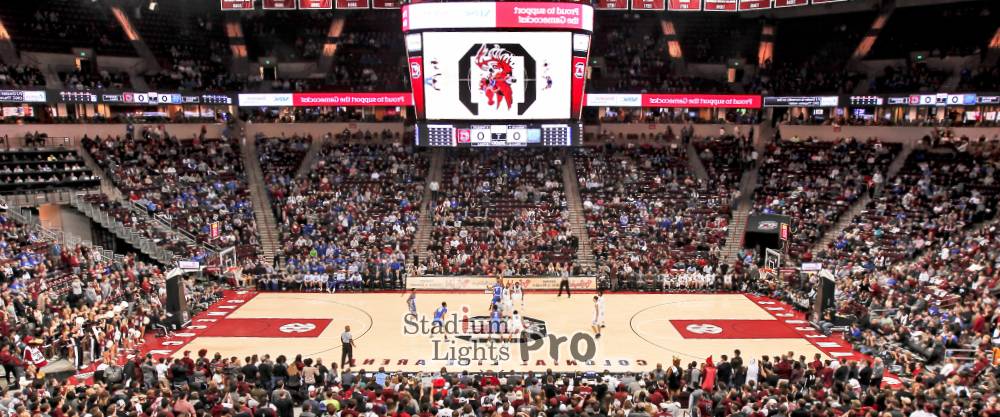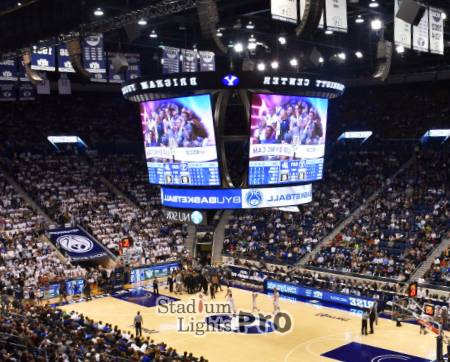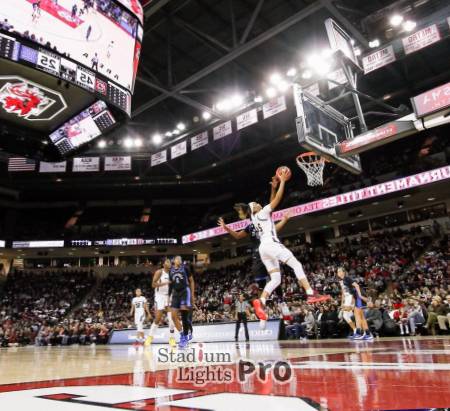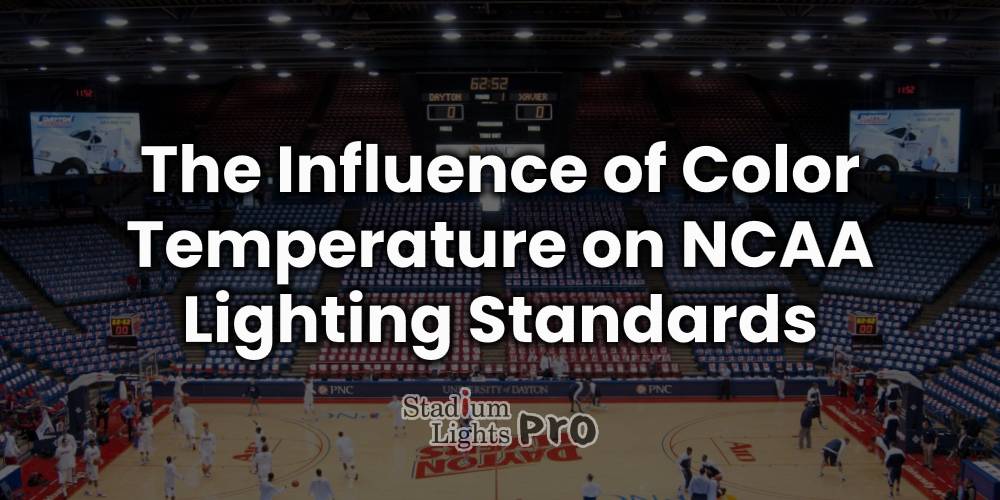Within the framework of NCAA (National Collegiate Athletic Association) regulations, lighting standards are not just a matter of functionality but are essential for ensuring fairness in competition. One critical aspect of these standards is the regulation of color temperature. The effect of color temperature on both athletes and spectators can influence the outcome of games and how they are perceived by those watching, whether in the stadium or via broadcast. Understanding how color temperature impacts both the game itself and the atmosphere around it is key to appreciating its role in NCAA sports.
Color temperature refers to the appearance of the light emitted by a light source, measured in Kelvins (K). A light’s color temperature can range from warm (yellowish or reddish) to cool (bluish or white). NCAA venues aim to strike a balance between these extremes, ensuring that the lighting used during games maximizes visibility, performance, and fairness. By examining how different color temperatures influence athletic performance, spectator experience, and the consistency across venues, it becomes evident how pivotal it is in creating a high-quality, equitable sports environment.
| Aspect | Warm Lighting (<3,000K) | Cool Lighting (5,000K – 6,500K) |
|---|---|---|
| Visual Clarity and Accuracy | Softer lighting; less effective at enhancing contrast, making it harder to track fast-moving objects. | High contrast, making it easier to differentiate between objects and track fast-moving balls. |
| Example in Basketball | Less effective for tracking the ball at high speeds. | The ball stands out clearly against the background, aiding quicker and more accurate reactions. |
| Example in Football | Harder to track a ball over long distances. | Enhances the ability to judge the trajectory of the ball, improving accuracy and reaction time. |
| Reducing Eye Strain and Fatigue | May contribute to visual fatigue and discomfort due to softer light. | Reduces visual fatigue and strain, allowing players to focus longer and make quicker decisions. |
| Impact on Performance | Possible decrease in focus and accuracy due to eye strain. | Enhanced performance due to better visual clarity and reduced eye strain. |
Table of Contents
ToggleWhat is Color Temperature?
Color temperature is a metric used to describe the color characteristics of a light source. The higher the color temperature (measured in Kelvins), the cooler and bluer the light appears. Conversely, the lower the color temperature, the warmer and more yellow or red the light looks. This measurement is used in various settings to adjust lighting conditions, ensuring that the atmosphere is ideal for the activities being carried out.
In sports lighting, a color temperature of around 5,000K to 6,500K is commonly used. This range is closest to daylight, providing clarity and improving contrast, which is crucial for both athletes and spectators. At these color temperatures, players can see clearly, and the contrast between the field, ball, and players is maximized. For fans, it ensures that they can view the game with sharp detail, creating an immersive and high-quality viewing experience. This consistency helps standardize the experience of NCAA sports across all venues.

The Role of Color Temperature in Athletic Performance
Visual Clarity and Accuracy in Movement
Athletes must make split-second decisions and react to rapid changes in the game, whether it’s tracking a basketball from one end of the court to another, positioning for a pass in soccer, or reacting to the trajectory of a flying football. Color temperature plays a direct role in how easily athletes can differentiate between objects, track fast-moving balls, and maintain a sense of spatial awareness on the field.
Warmer light temperatures, below 3,000K, tend to create softer lighting and are often less effective at enhancing contrast, making it harder for athletes to track the ball or identify fast-moving objects in their environment. Cooler color temperatures, typically around 5,000K to 6,500K, create high contrast, which makes it easier for players to pick out details from their surroundings. This is particularly important for activities that involve rapid movement or need high levels of coordination and visual tracking.
In basketball, for example, players need to track the ball as it moves across the court, often at high speeds. Under cooler lighting, the ball stands out more clearly against the background, helping players react faster and with greater accuracy. In a sport like football, athletes often need to track a ball that is thrown over long distances, requiring them to judge the ball’s trajectory with precision. The cool color temperature enhances their ability to see the ball clearly, regardless of the lighting conditions.
Reducing Eye Strain and Fatigue
Another consideration when evaluating the impact of color temperature on performance is the potential for visual fatigue. When the lighting is either too harsh or not sufficient, athletes may experience eye strain, which can decrease their focus and overall performance. Over time, this can lead to errors in judgment and delayed reactions. Lighting that is neither too warm nor too cool, but instead falls within an optimal range, helps reduce the strain on athletes’ eyes, allowing them to perform without discomfort. Cool lighting, typically around 5,000K to 6,500K, is less likely to cause fatigue, enhancing the players’ ability to focus throughout the game. This leads to fewer errors, faster decision-making, and higher levels of performance.
Color Temperature and Spectator Experience
Enhancing Visual Appeal for Viewers
 Spectators play a major role in the energy and atmosphere of an NCAA event. Whether they are physically present in the stadium or watching from home, fans expect to experience a visually engaging and exciting event. Color temperature impacts how the game is presented on screen and how it is perceived in person. Lighting that is either too warm or too cool can distort the appearance of uniforms, the ball, and the field. This makes it difficult for fans to engage fully with the game.
Spectators play a major role in the energy and atmosphere of an NCAA event. Whether they are physically present in the stadium or watching from home, fans expect to experience a visually engaging and exciting event. Color temperature impacts how the game is presented on screen and how it is perceived in person. Lighting that is either too warm or too cool can distort the appearance of uniforms, the ball, and the field. This makes it difficult for fans to engage fully with the game.
With cooler color temperatures, generally in the range of 5,000K to 6,500K, the color of the playing surface, uniforms, and ball are more accurately represented, creating a clearer and more vibrant visual experience for the spectators. Whether watching a game from the stands or from a screen, fans can more easily follow the action, which enhances their enjoyment of the event. The colors of the game appear sharp, with high contrast between the players, the ball, and the environment, ensuring that viewers can follow every moment of the action.
Mood and Atmosphere
Color temperature also contributes to the mood of the event. Cool lighting is often associated with energy, focus, and alertness. In NCAA sports, where intensity and excitement are crucial, the color temperature used in the venue can impact the overall atmosphere. A cooler color temperature helps create a dynamic and energetic environment, which fuels the excitement of both players and spectators. This, in turn, heightens the overall game experience and fosters a sense of anticipation, particularly during high-stakes moments like crucial goals, touchdowns, or points.
The lighting used in the venue directly influences how fans feel about the event. When the lighting is vibrant and clear, it enhances the sense of action and urgency that athletes experience, which is contagious to the fans. The interplay of high-contrast, cooler lighting helps to create an environment where the crowd feels energized and immersed in the competition.
Ensuring Fairness Across NCAA Venues
Consistent Lighting Conditions
 One of the NCAA’s primary responsibilities is to ensure that every game is played under conditions that give both teams a fair chance. This extends to the lighting conditions in each venue. Without consistent lighting, one team may benefit from more favorable lighting conditions than the other, creating a disadvantage in terms of visibility and perception.
One of the NCAA’s primary responsibilities is to ensure that every game is played under conditions that give both teams a fair chance. This extends to the lighting conditions in each venue. Without consistent lighting, one team may benefit from more favorable lighting conditions than the other, creating a disadvantage in terms of visibility and perception.
To prevent this from happening, the NCAA sets standards for the color temperature used across all venues. This consistency ensures that athletes, regardless of the venue, are performing under similar lighting conditions, which helps maintain the fairness of the competition. Whether the game is played in a small, intimate arena or a large, open stadium, the uniform color temperature ensures that no team has an advantage related to the quality of the lighting.
Impact on Officiating
Lighting standards are not only relevant to athletes and spectators but also play a critical role in how the game is officiated. Accurate officiating depends on the ability of referees and other officials to see the action clearly. If the lighting conditions are poor, referees may miss critical calls or misjudge certain aspects of the game, which could affect the outcome of the match. By standardizing color temperature, the NCAA ensures that officiating is fair and that referees have the optimal visual conditions to make accurate decisions.
The Health and Well-being of Athletes
Enhancing Focus and Alertness
The color temperature of lighting can also affect the well-being of athletes. Research suggests that exposure to certain color temperatures can have a direct impact on mood, cognitive function, and alertness. Cooler light temperatures, similar to natural daylight, are known to enhance focus, improve reaction times, and increase alertness, all of which are essential for high-performance athletes.
When athletes compete under the right lighting conditions, they are more likely to stay mentally focused and engaged throughout the game. Proper lighting helps maintain cognitive function, reducing the chances of mistakes due to mental fatigue. By providing lighting that encourages focus, the NCAA helps ensure that athletes are performing at their best and that the competition remains fair.
Eye Protection and Comfort
Poorly designed lighting can lead to visual discomfort and eye strain, which can hinder performance. Constant exposure to harsh lighting can lead to headaches, fatigue, and irritation, which negatively affects an athlete’s ability to perform. By ensuring that the color temperature falls within the optimal range, the NCAA helps protect athletes from unnecessary strain and discomfort.
Technological Advances in Lighting Systems
LED Lighting and Customization
The advent of LED lighting has revolutionized how sports venues manage lighting conditions. LEDs offer improved energy efficiency, longer lifespans, and more precise control over the light emitted. This flexibility allows venues to adjust the color temperature and intensity to suit specific needs, including different sports and times of day.
In the past, lighting systems were more rigid, and it was difficult to fine-tune conditions to optimize performance. With modern LED systems, it is possible to set a precise color temperature that best suits the venue and the event, improving both visibility and overall game experience. Venues can also use adaptive systems that adjust the lighting throughout the game, ensuring that the lighting conditions stay optimal as the natural light changes or as the game progresses into the evening.
Smart Lighting Systems for Future Events
The next frontier in sports lighting is smart lighting technology, which promises even greater levels of customization and automation. These systems use sensors and artificial intelligence to monitor lighting conditions in real time and adjust the color temperature accordingly. For instance, the system could automatically increase the color temperature to simulate daylight during an outdoor game or adjust it for indoor settings during evening matches.
Smart lighting can also respond to the dynamics of the game itself. For example, the lighting could brighten or change color to match the intensity of critical moments, such as a game-winning shot or a touchdown. This technology can help enhance both the athlete’s performance and the fan experience, offering a level of control previously unavailable in traditional lighting systems.
Maintaining NCAA Lighting Consistency Across All Venues
Standardization Across Various Venue Types
One of the key challenges for the NCAA is ensuring that lighting conditions remain consistent across its vast network of venues. These venues vary greatly in terms of size, design, and location. Some are large stadiums, while others are smaller arenas. Regardless of the venue’s physical characteristics, the NCAA enforces strict lighting standards that ensure all games are played under the same color temperature conditions. This commitment to consistency ensures that no matter where a game is held, the playing environment remains fair for all teams involved.
The NCAA’s Role in Ensuring Uniform Lighting Standards
By maintaining strict lighting regulations, the NCAA helps create a level playing field for every team that competes under its auspices. Standardized lighting conditions ensure that athletes can focus on their performance without worrying about disparities in visibility or lighting quality. Spectators can expect the same visual quality and clarity, regardless of which venue they are in, enhancing their overall experience and enjoyment of the event.
Overall Insights
The regulation of color temperature in NCAA sports venues has far-reaching consequences for both the performance of athletes and the experience of spectators. By standardizing lighting conditions across venues and ensuring that the color temperature is consistently set within an optimal range, the NCAA supports fair play, enhances visual clarity, and fosters an immersive experience for all involved. As lighting technology advances, the NCAA will continue to adapt its standards to further enhance the fairness, quality, and excitement of athletic competition.

